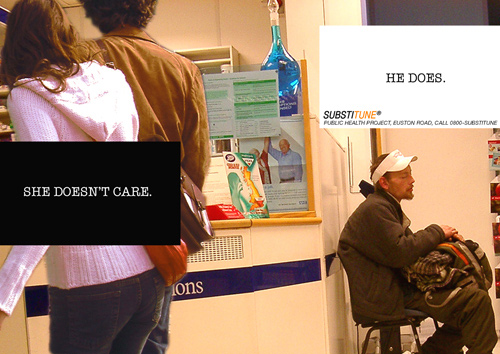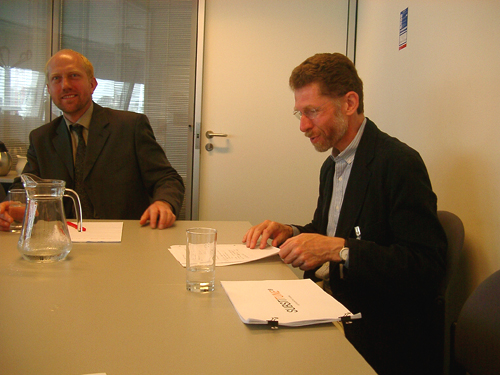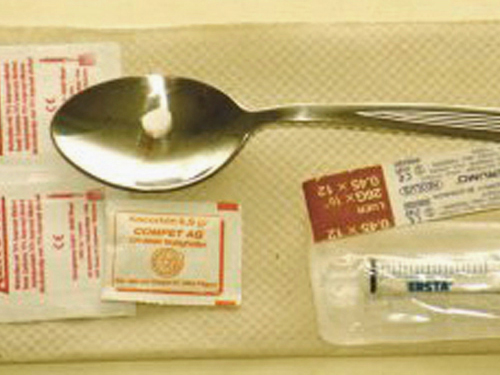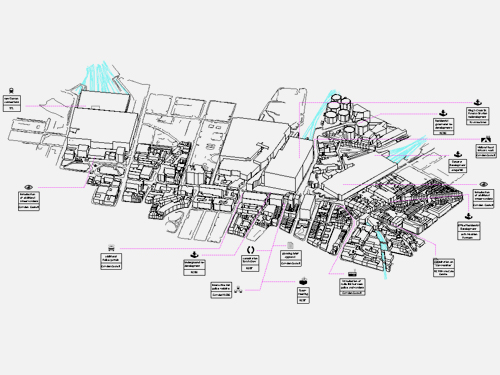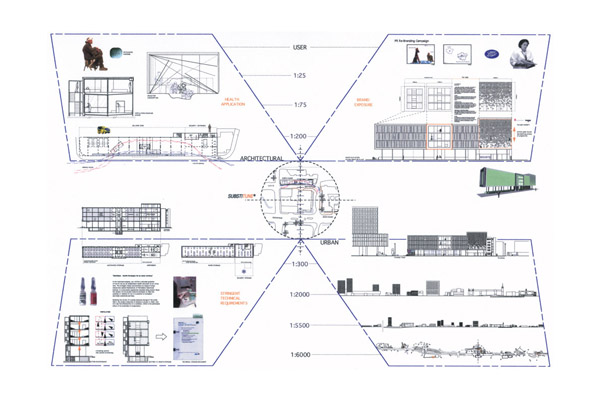Substitune®
Research, Proposal and Framework Design
2004
London, UK
- Commissioned by Greater London Authority
- Research Institution: Architectural Association
- Research, Proposal and Framework Design by Markus Miessen
“One Londoner dies every thirty hours because of drug misuse.” (Greater London Authority)
This case study introduces a strategic framework design for an alternative health structure as a result of an architect’s participation in the socio-political environment. Based on an understanding of participation beyond models of consensus, it deals with both the individual and the institution, while proposing an interactive mechanism for collaboration that creates a fragmented urban service construct with specific architectural projects.
As a reaction to the ongoing redevelopment of London’s King’s Cross interchange, the introduction of a service-interface attempts to create an economically independent health service, which operates autonomously from Borough-specific National Health Service (NHS) funding. This new methadone substitute programme caters for those users who are unable to register with General Practitioners and rely on services, which are accessible only to those registered with their local council. As a piece of urban infrastructure, a network of eight specific sites along the Euston Road generates an alternative financing scheme, which cross-references between the utilisation of an institution and real estate. Without following a stipulated morale, the project provides guidance on what is required to set up a health service on three different scales of a fragmented, but unified institution.
Substitune proposes an alternative approach to entrenched drug use and related problems associated with the King’s Cross area, one which replaces the single, homogeneous control mechanism with a number of adjustable and responsive mechanisms spanning different fields, professions and scales. On an urban scale, this project takes as its starting point the idea that a building does not necessarily emerge as an architectural envelope alone. The project generates its structure from the existing statutory conditions (legal/political/territorial framework) of the identified territory and calls for a fragmented service building, which includes four facades along the Euston Road, and a central core that acts as a warehouse for controlled drugs as well as a dispensary for methadone-based programmes. By incorporating Boots–a nationwide chain of pharmacies–as a major economic factor, Substitune’s architectural application of a delivery centre joined with a public health-centre/dispensary challenges the conventional understanding of the politically operated urban health system.
The first component of this project entailed identifying key clients in the marginalised social envelope of the redevelopment – individuals who are either already on local programmes or willing to get into them. Setting up new structures necessarily involves respecting and utilising existing programmes and structures, and although the territory possesses such structures in abundance, they have not been networked effectively. It quickly became clear that reliance on NHS funding was a major obstacle. This conclusion was based on the ineffective practice of drug-related funding, which is organised by territory rather than need. Since participants in long-term drug treatment programmes must be registered with the council, the homeless or those who live just across the boundary between Camden and Islington councils are effectively denied access to local services. To allow ease of access, both physical and bureaucratic, Substitune would clearly need to operate outside the framework of the NHS. A possible solution to these spatial and economic issues presented itself in the form of Boots, the UK’s largest chain of chemists, with 156 outlets in London alone. Currently the company’s storefronts serve as one of the primary sites for the dispensing of methadone, but it is not a role that sits easily alongside the day-to-day provision of hair care and dental products, aspirin and sandwiches. Nor, despite their ubiquity, do Boots branches provide any other service in the long line of needs the typical methadone user will require, ranging from initial assessment to diagnosis, treatment and monitoring. This potential spare capacity, combined with shortcomings in its current setup, identified Boots as a possible key factor within the local dispensing scheme, and formal meetings were held to present the company with proposals.
Policy issues raised in the research study were addressed in a symposium held at London’s City Hall (Greater London Authority). The symposium was set up as a result of negotiations with both the GLA and related mayoral bodies (i.e. the London Health Commission). Attended by representatives of collaborating institutions and practices, the symposium covered the central topics of prescription-drug distribution and urban health systems in a formal manner. Should the Substitune project go ahead, this session would be the first in a series of annual meetings in which the programme would be evaluated and subsequently altered according to need and local change. It would effectively become a mechanism for controlling architecture over time.
Investigating forces that influence, generate and control the city, the project attempts to stress the significance of political, economic and social mechanisms of change as an alternative to the large-scale formal approach to transforming the urban fabric. This continuous transformation of one’s own practice is part of the larger transformation of the cultural landscape, which is the result of the instability of a society that consists of many distinct and often conflicting individuals, institutions and spaces.
